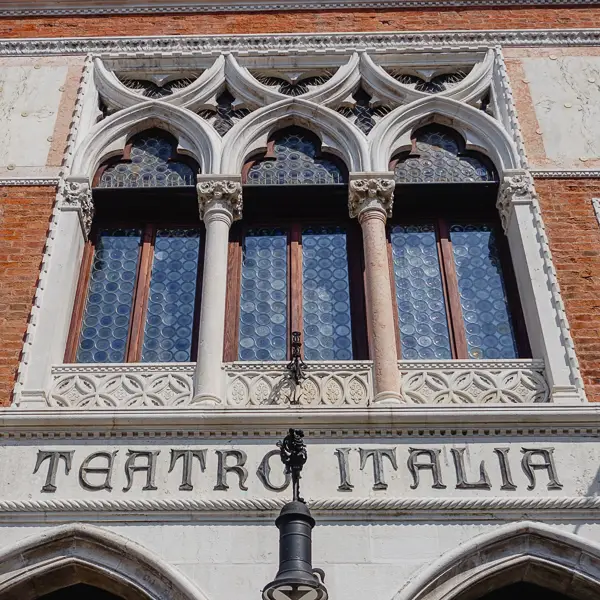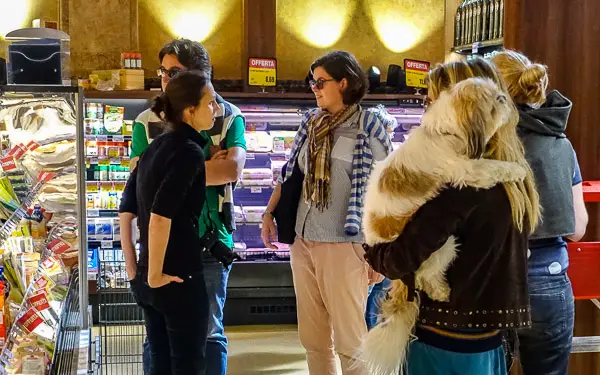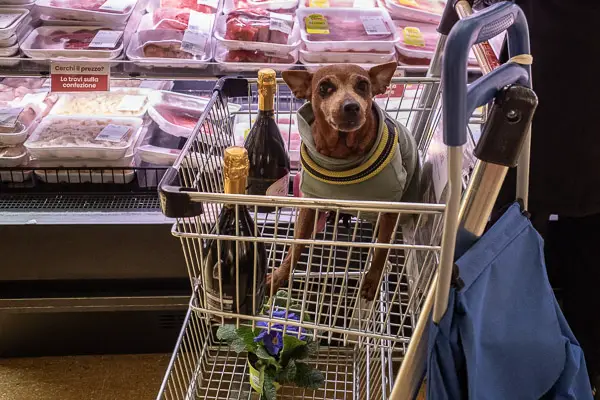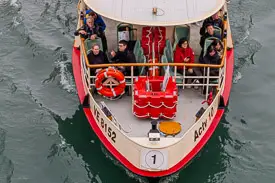|
|
| Venice Home | All topics |
| Where to stay | Transportation |


|
|
Venice Supermarkets
ABOVE: Despar's Venice flagship store, in the renovated Teatro Italia movie theater, may be the most beautiful supermarket you'll ever visit.
Not so many years ago, Venice was a city of neighborhood alimentari or grocery stores, cheese shops, meat markets, and produce vendors. Supermarkets were few and far between. Times have changed, and today you'll supermarkets in most of Venice's sestieri or districts. That's bad news for traditionalists, but it's good news if you're a foreign tourist who's intimidated by unfamiliar shopping customs and language barriers. Shopping at a supermarket can be a time-saver when you're stocking the refrigerator of your vacation apartment or browsing for snacks to keep in your hotel room. It also lets you mingle with the locals in an everyday, real-life environment. Despar
ABOVE: The Despar Teatro Italia resembles an ancient palazzo. It's located on the Campiello dell'Anconeta, along the main walking route between Venice's railroad station and the Piazza San Marco. Of the grocery chains in Venice, our favorite may be Despar, which has increased its Venice footprint in recent years. Its store in the former Teatro Italia, a former cinema, is a fake Venetian Gothic architectural masterpiece with a great selection of foods.
Despar is the only supermarket in Venice with consistently good breads, rolls, and pastries, which you can buy from plexiglass bins. (You'll need to use plastic gloves when selecting items from the bulk bins.) Coop
Another popular chain is Coop, which has more supermarkets in Venice than any of its competitors. The largest stores are located just off the Piazzale Roma (facing vaporetto platform "D") and on the Strada Nova, which is one of Venice's main pedestrian thoroughfares. Small and medium-size Coop or InCoop stores are scattered around the city center and on Lagoon islands such as Murano. Coop, pronounced "Cope," is notable for its high-quality and competitively-priced store brands. (I'm a big fan of its special coffee for Moka pots, which are the coffeemakers you're most likely to find in Venice vacation apartments.) Conad
ABOVE: This Conad City branch faces the Giudecca Canal on the Fondamenta delle Zattere, next to the San Basilio vaporetto station. It looks small from the outside, but its modest entrance hides a large supermarket. Conad has a growing number of stores in the centro storico and on the Lido di Venezia. Two of our favorites are on the Fondamenta delle Zattere (facing the Giudecca Canal) and in the far northwestern reaches of Cannaregio, where you'll find what may be the biggest and least crowded supermarket in Venice. The latter (shown below) is a convenient place to stock up on groceries for your vacation apartment, thanks to its wide aisles and large selection of foods.
ABOVE: The largest supermarket in central Venice is probably this modern Conad City store, which is tucked away in a residential neighborhood near the northwestern tip of Cannaregio. Other supermercati:
ABOVE: This small, traditional-looking Crai supermarket in Venice's Castello district used to be a latteria or dairy shop. Additional supermarket brands in central Venice include Crai, Prix (a discount chain with a handful of neighborhood stores), and Bailo (which had three small stores in central Venice the last time we checked). Supermarket shopping tips:
ABOVE: Many supermarkets have waiting areas where you can leave your dog when you shop. (Often, the locals just let their unleashed dogs wait outside in the car-free street.)
Map links:
ABOVE: A small Coop supermarket overlooks the pretty Campo San Giacomo dall'Orio in Venice's district of San Polo. Venice has so many supermarkets that you really don't need a map to find one. However, the following Google Maps links will be useful if you want to reach the city's largest or most distinctive supermercati: Please note: The precision of Google Maps can vary by device, so if you don't see a large red marker, drag the map until you do. More photos:
ABOVE: The Coop Querini Castello supermarket on the right (behind the arched doorway) is in a boatyard just east of the Fondamente Nove, beyond the Ospedale Civile or municipal hospital. Look for a door in the boatyard's brick wall, which is open during business hours.
ABOVE: You'll find another Coop around the corner from the Piazzale Roma, next to a vaporetto stop. (Look for platform "D.") It occupies several converted warehouses and is next door to a DM health & beauty aids shop.
ABOVE: Some of Conad's smaller stores have been relabeled with the "Tuday" brand.
ABOVE: Supermarket brands come and go, but the stores stay put. This large and modern Despar (formerly Crai, and before that Punto) reflects a church's façade in Venice's San Marco district.
ABOVE: A truck on a barge delivers groceries to the Conad City supermercato on the Fondamenta della Zattere.  
ABOVE: Venetians can be brazen about shopping with their dogs. 
Venice for first-time visitors:
|
|
| Venice for Visitors - Home | | Europe for Visitors - Home | | About our site | | Press clippings | | Testimonials |
Disclosure: Where hotel or other reservation links point to third-party booking sites, we may receive a small commission on transactions. This will not affect the rate you pay. Copyright © 1996-2025 Durant and Cheryl Imboden. All rights reserved. |